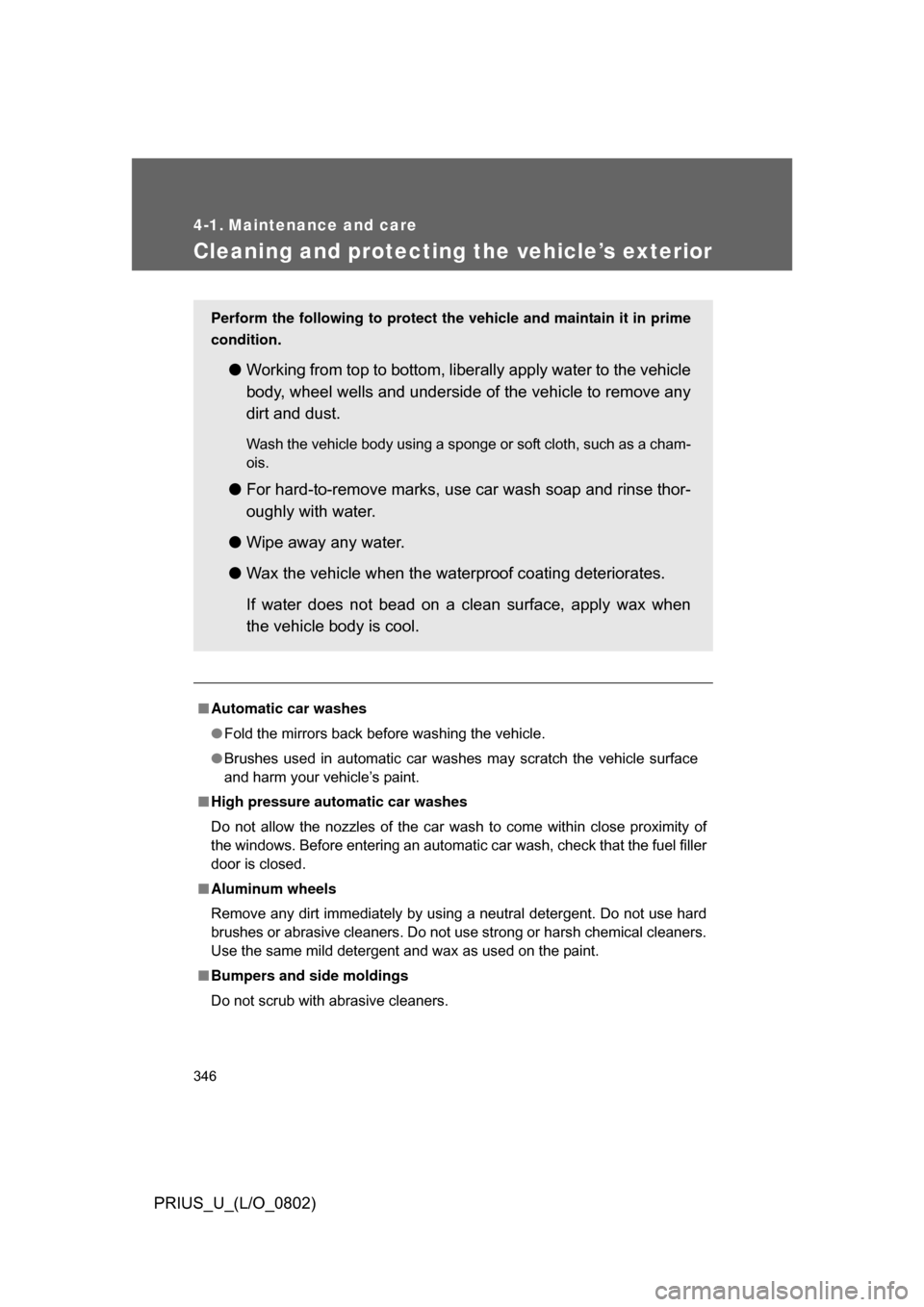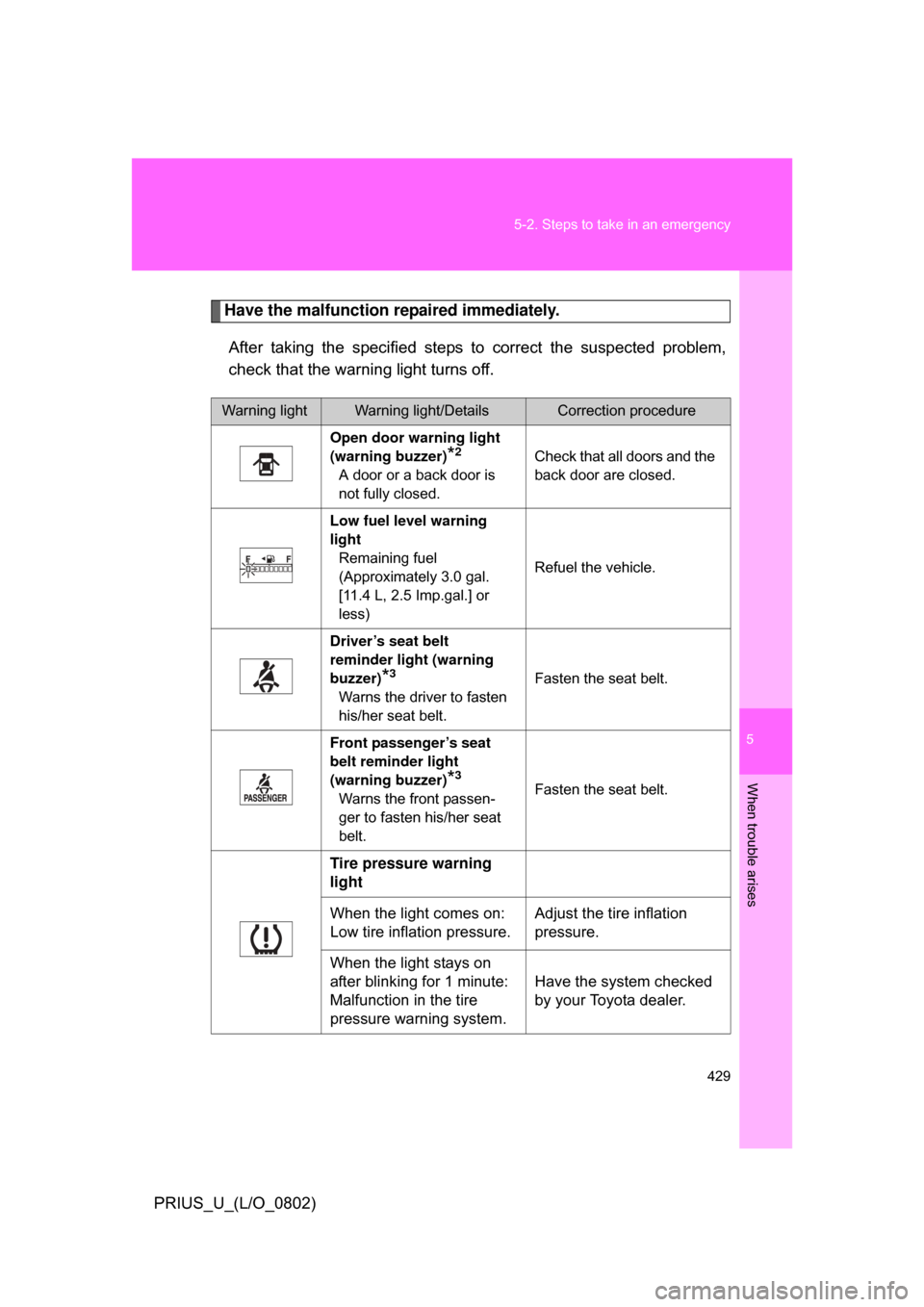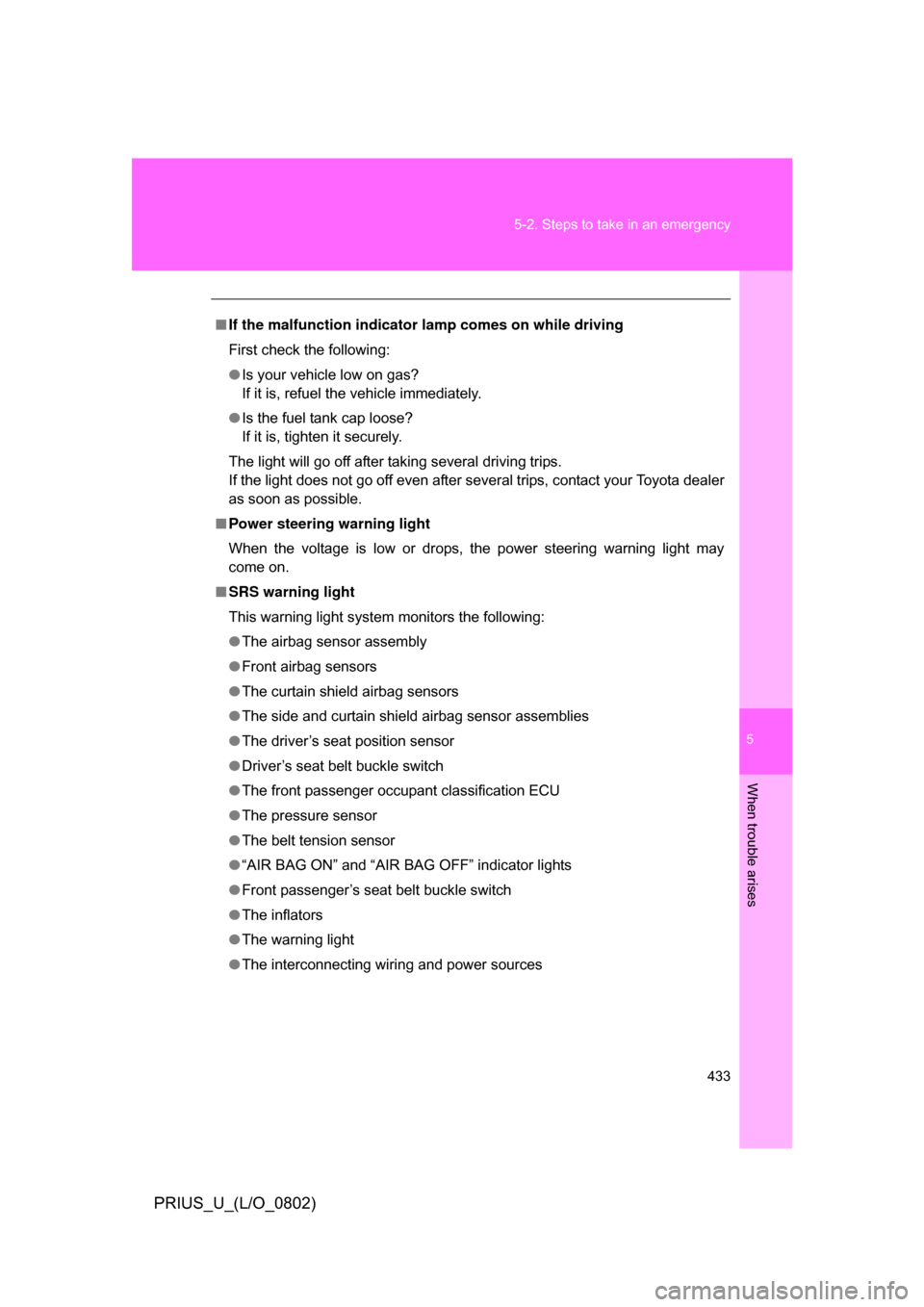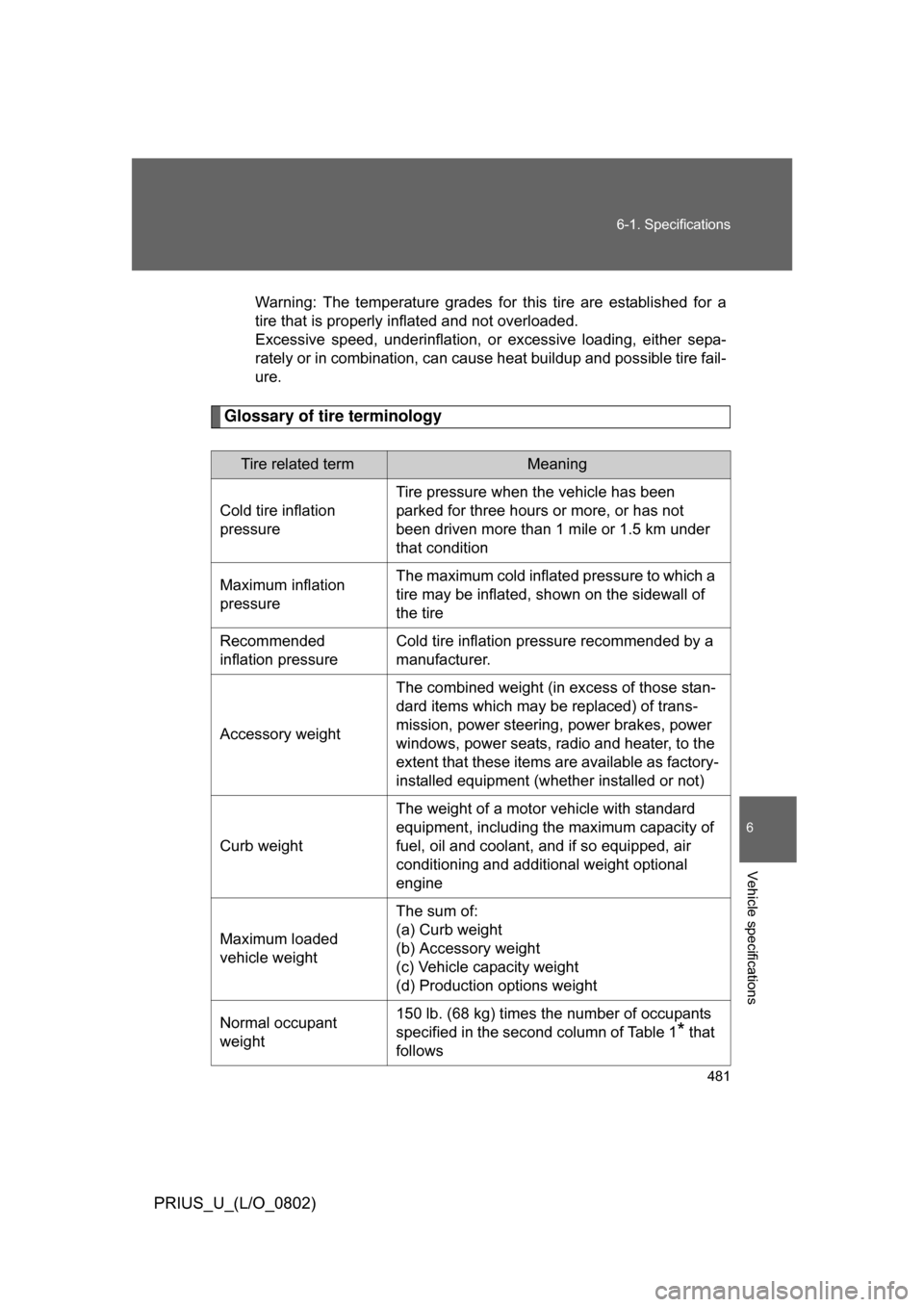Page 7 of 512
7
PRIUS_U_(L/O_0802)
Tire
●Rotation
● Replacement
● Inflation pressure
● Information
P. 379
P. 438
P. 470
P. 474
Tail and rear side marker lights P. 150
Back door P. 54Side door P. 51
Fuel filler door P. 78
Turn signal light P. 140
: If equipped
Rear window wiper P. 162
Back-up light
Licence plate lights
P. 150
Rear window defogger P. 217
Page 346 of 512

346
PRIUS_U_(L/O_0802)
4-1. Maintenance and care
Cleaning and protecting the vehicle’s exterior
■Automatic car washes
● Fold the mirrors back before washing the vehicle.
● Brushes used in automatic car washes may scratch the vehicle surface
and harm your vehicle’s paint.
■ High pressure automatic car washes
Do not allow the nozzles of the car wash to come within close proximity of
the windows. Before entering an automatic car wash, check that the fuel filler
door is closed.
■ Aluminum wheels
Remove any dirt immediately by using a neutral detergent. Do not use hard
brushes or abrasive cleaners. Do not use strong or harsh chemical cleaners.
Use the same mild detergent and wax as used on the paint.
■ Bumpers and side moldings
Do not scrub with abrasive cleaners.
Perform the following to protect the vehicle and maintain it in prime
condition.
● Working from top to bottom, liber ally apply water to the vehicle
body, wheel wells and underside of the vehicle to remove any
dirt and dust.
Wash the vehicle body using a sponge or soft cloth, such as a cham-
ois.
● For hard-to-remove marks, use car wash soap and rinse thor-
oughly with water.
● Wipe away any water.
● Wax the vehicle when the waterproof coating deteriorates.
If water does not bead on a clean surface, apply wax when
the vehicle body is cool.
Page 390 of 512

390 4-3. Do-it-yourself maintenance
PRIUS_U_(L/O_0802)
■Effects of incorrect tire inflation pressure
Driving with incorrect tire inflation pressure ma y result in the following:
●Reduced fuel efficiency
●Reduced driving comfort and tire life
●Reduced safety
●Damage to the drive train
If a tire needs frequent re filling, have it checked by your Toyota dealer.
■Instructions for checking tire inflation pressure
When checking tire inflation pressure, observe the following:
●Check only when the tires are cold.
If your vehicle has been parked for at least 3 hours and has not been
driven for more than 1 mile or 1.5 km, you will get an accurate cold
tire inflation pressure reading.
●Always use a tire pressure gauge.
The appearance of the tire can be mi sleading. In addition, tire infla-
tion pressures that are even just a few pounds off can degrade ride
and handling.
●Do not bleed or reduce tire inflation pressure after driving. It is normal
for the tire inflation pressure to be higher after driving.
●Never exceed the vehicle capacity weight.
Passengers and luggage weight should be placed so that the vehicle
is balanced.
Page 429 of 512

5
When trouble arises
429
5-2. Steps to take in an emergency
PRIUS_U_(L/O_0802)
Have the malfunction repaired immediately.
After taking the specified steps to correct the suspected problem,
check that the warning light turns off.
Warning lightWarning light/DetailsCorrection procedure
Open door warning light
(warning buzzer)
*2
A door or a back door is
not fully closed.
Check that all doors and the
back door are closed.
Low fuel level warning
light Remaining fuel
(Approximately 3.0 gal.
[11.4 L, 2.5 Imp.gal.] or
less) Refuel the vehicle.
Driver’s seat belt
reminder light (warning
buzzer)
*3
Warns the driver to fasten
his/her seat belt. Fasten the seat belt.
Front passenger’s seat
belt reminder light
(warning buzzer)
*3
Warns the front passen-
ger to fasten his/her seat
belt. Fasten the seat belt.
Tire pressure warning
light
When the light comes on:
Low tire inflation pressure.
Adjust the tire inflation
pressure.
When the light stays on
after blinking for 1 minute:
Malfunction in the tire
pressure warning system. Have the system checked
by your Toyota dealer.
Page 433 of 512

5
When trouble arises
433
5-2. Steps to take in an emergency
PRIUS_U_(L/O_0802)
■
If the malfunction indicator lamp comes on while driving
First check the following:
● Is your vehicle low on gas?
If it is, refuel the vehicle immediately.
● Is the fuel tank cap loose?
If it is, tighten it securely.
The light will go off after taking several driving trips.
If the light does not go off even after several trips, contact your Toyota dealer
as soon as possible.
■ Power steering warning light
When the voltage is low or drops, the power steering warning light may
come on.
■ SRS warning light
This warning light system monitors the following:
● The airbag sensor assembly
● Front airbag sensors
● The curtain shield airbag sensors
● The side and curtain shield airbag sensor assemblies
● The driver’s seat position sensor
● Driver’s seat belt buckle switch
● The front passenger occupant classification ECU
● The pressure sensor
● The belt tension sensor
● “AIR BAG ON” and “AIR BA G OFF” indicator lights
● Front passenger’s seat belt buckle switch
● The inflators
● The warning light
● The interconnecting wiring and power sources
Page 436 of 512

436 5-2. Steps to take in an emergency
PRIUS_U_(L/O_0802)
CAUTION
■Maintenance of the tires
Each tire, including the spare (if provided), should be checked monthly
when cold and inflated to the inflation pressure recommended by the
vehicle manufacturer on the vehicle placard or tire inflation pressure
label (tire and load information label). (If your vehicle has tires of a differ-
ent size than the size indicated on the vehicle placard or tire inflation
pressure label [tire and load information label], you should determine the
proper tire inflation pr essure for those tires.)
As an added safety feature, your vehicle has been equipped with a tire
pressure monitoring system (TPMS-ti re pressure warning system) that
illuminates a low tire pressure telltal e (tire pressure warning light) when
one or more of your tires is significantly under-inflated. Accordingly,
when the low tire pressu re telltale (tire pressure warning light) illumi-
nates, you should stop and check your tires as soon as possible, and
inflate them to the proper pressure. Driving on a significantly under-
inflated tire causes the tire to overheat and can lead to tire failure.
Under-inflation also reduces fuel effi ciency and tire tread life, and may
affect the vehicle’s handling and stopping ability.
Please note that the TPMS (tire pressure warning system) is not a sub-
stitute for proper tire main tenance, and it is the driver’s responsibility to
maintain correct tire pressure, even if under-inflation has not reached the
level to trigger illu mination of the TPMS low tire pressure telltale (tire
pressure warning light).
Page 439 of 512

5
When trouble arises
439
5-2. Steps to take in an emergency
PRIUS_U_(L/O_0802)
■The compact spare tire
●The compact spare tire is identifi
ed by the label “TEMPORARY USE
ONLY” on the tire sidewall.
Use the compact spare tire temporarily only in an emergency.
●Make sure to check the tire inflation pressure of the compact spare
tire. ( P. 470)
■Tread life
The compact spare tire can be used many times, if necessary. It has
tread life of up to 3000 miles (4800 km) depending on road conditions
and your driving habits. When tread wear indicators appear on the tire,
replace the tire. ( P. 379)
■When using the compact spare tire
As the spare tire is not equipped with the tire pressure warning valve and
transmitter, low inflatio n pressure of the spare tire will not be warned.
Also, if you replace the compact spare tire after the tire pressure warning
light comes on, the light remains on.
■ Compact spare tire
The compact tire saves space in your luggage compartment,
and its lighter weight helps to enhance fuel economy and per-
mits easier installation in case of a flat tire.
The compact spare tire is
designed for temporary emer-
gency use only.
Page 481 of 512

481
6-1. Specifications
6
Vehicle specifications
PRIUS_U_(L/O_0802)
Warning: The temperature grades for this tire are established for a
tire that is properly inflated and not overloaded.
Excessive speed, underinflation, or
excessive loading, either sepa-
rately or in combination, can caus e heat buildup and possible tire fail-
ure.
Glossary of tire terminology
Tire related termMeaning
Cold tire inflation
pressure Tire pressure when the vehicle has been
parked for three hours or more, or has not
been driven more than 1 mile or 1.5 km under
that condition
Maximum inflation
pressure The maximum cold inflated
pressure to which a
tire may be inflated, s hown on the sidewall of
the tire
Recommended
inflation pressure Cold tire inflation pressure recommended by a
manufacturer.
Accessory weight The combined weight (in excess of those stan-
dard items which may be replaced) of trans-
mission, power steering, power brakes, power
windows, power seats, radio and heater, to the
extent that these items
are available as factory-
installed equipment (whether installed or not)
Curb weight The weight of a motor vehicle with standard
equipment, including the maximum capacity of
fuel, oil and coolant, and if so equipped, air
conditioning and additional weight optional
engine
Maximum loaded
vehicle weight The sum of:
(a) Curb weight
(b) Accessory weight
(c) Vehicle capacity weight
(d) Production options weight
Normal occupant
weight 150 lb. (68 kg) times the number of occupants
specified in the second column of Table 1
* that
follows